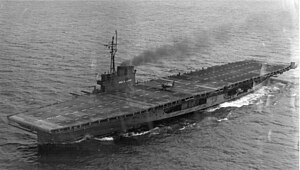| USS Sable (IX-81) | |
|---|---|
 USS Sable IX-81 | |
| Career | |
| Name: | Greater Buffalo |
| Owner: | Detroit and Cleveland Navigation Company |
| Route: | Buffalo to Detroit |
| Builder: | American Ship Building Company of Lorain, Ohio |
| Way number: | 786 |
| Launched: | 27 October 1923 |
| Identification: | US 223663 |
| Fate: | Acquired by the United States Navy on 7 August 1942. |
| Career (United States) | |
| Name: | USS Sable |
| Namesake: | Sable |
| Acquired: | 7 August 1942 |
| Commissioned: | 8 May 1943 |
| Decommissioned: | 7 November 1945 |
| Struck: | 28 November 1945 |
| Fate: | Sold on 7 July 1948 for scrapping. |
| General characteristics | |
| Displacement: |
7,739 long tons (7,863 t) (as Greater Buffalo); 6,584 long tons (6,690 t) (as Sable) |
| Length: |
518.7 ft (158.1 m) (as Greater Buffalo); 535 ft (163 m) (as Sable) |
| Beam: | 58 ft (18 m) (as Greater Buffalo and Sable) |
| Height: | 21.3 ft (6.5 m) (as Greater Buffalo) |
| Propulsion: |
Inclined compound steam engine
|
| Speed: | 18 knots (33 km/h)[2] |
USS Sable (IX-81) was a training ship of the United States Navy during World War II.[3] Originally built as the Greater Buffalo, a sidewheel excursion steamer, she was converted in 1942 to a freshwater aircraft carrier to be used on the Great Lakes. She was used for advanced training for naval aviators in carrier takeoffs and landings. One aviator that trained upon the Sable was future president George H. W. Bush.[3]
Following World War II, Sable was decommissioned on 7 November 1945. She was sold for scrapping on 7 July 1948 to the H.H. Buncher Company.
Construction[]
Formerly named Greater Buffalo, Sable was originally built in 1924 by the American Ship Building Company of Lorain, Ohio as a sidewheel excursion steamer designed by marine architect Frank E. Kirby. When completed, Greater Buffalo was 518.7 ft (158.1 m) in length, a beam of 58 ft (18 m), height of 21.3 ft (6.5 m) and had a 7,739 long tons (7,863 t). She was powered by a three-cylinder inclined compound steam engine.[1] She was six passenger decks high and carried three funnels along her top.
History[]
One of the largest ships on the Great Lakes,[citation needed] she served from 1924–1942, Greater Buffalo was used as a palatial overnight service boat transporting up to 1,500 passengers from Buffalo to Detroit for the Detroit and Cleveland Navigation Company.[3] She was acquired for Navy use on 7 August 1942 by the War Shipping Administration to be converted in to a training aircraft carrier and renamed Sable on 19 September 1942.[4]
Refit[]
Sable was converted at the Erie Plant of American Shipbuilding Company[5] at Buffalo, New York.[4] The cabins and superstructure of the ship were removed leaving the main deck. Along with additional supports, a steel flight deck was installed instead of the originally planned Douglas-fir wooden deck similar to what was installed on USS Wolverine (IX-64).[3] Sable lacked a hangar deck, elevators or armament, as her role was for the training of pilots for carrier take-offs and landings.[6] Sable was commissioned on 8 May 1943, Captain Warren K. Berner in command.
Training duty[]

Two Naval Aircraft Factory TDN assault drones aboard Sable.
The completed Sable departed Buffalo on 22 May 1943 and arrived at her assigned homeport of Chicago, Illinois on 26 May 1943.[4] Sable along with her sister ship, Wolverine, were assigned to the 9th Naval District Carrier Qualification Training Unit (CQTU) and qualified pilots for carrier operations. Sable's steel deck was used for testing non-skid material on the flight deck as well as her normal duties.[3] Following the end of World War II, Sable was decommissioned on 7 November 1945 and struck from the Naval Vessel Register on 28 November 1945.[4] She was sold by the Maritime Commission to H. H. Buncher Company on 7 July 1948 and was reported as "disposed of" on 27 July 1948.[4]
Legacy[]
Together, Sable and Wolverine trained 17,820 pilots in 116,000 carrier landings. Of these, 51,000 landings were on Sable alone. One of the pilots qualified on Sable was a 20-year-old Lieutenant, junior grade, future president George H. W. Bush.[3] Of the estimated 135–300 aircraft lost during training, 35 have been salvaged and the search for more is underway.[7][8]
See also[]
- Frank E. Kirby
- SS Canadiana
- Buffalo, New York
- MV Aquarama
References[]
- ↑ 1.0 1.1 "Greater Buffalo.". Fr. Edward J. Dowling, S.J. Marine Historical Collection. University of Detroit Mercy. http://www.dalnet.lib.mi.us/gsdl/cgi-bin/library?e=d-000-00---0shipping--00-0-0-0prompt-10---4---Document---0-1l--1-en-50---20-about---001-011-1-0utfZz-8-0&a=d&c=shipping&cl=CL1.7.35&d=HASH019bace0a88a29e2e8ee7d5a. Retrieved 19 July 2009.
- ↑ Silverstone, Paul H (1965). US Warships of World War II. Annapolis, Maryland: Naval Institute Press. ISBN 0-87021-773-9.
- ↑ 3.0 3.1 3.2 3.3 3.4 3.5 "The Greater Buffalo & The U.S.S. Sable". WNY Heritage Press. 2005. http://wnyheritagepress.org/photos_week_2005/greater_buffalo/greater_buffalo.htm. Retrieved 19 July 2009.
- ↑ 4.0 4.1 4.2 4.3 4.4 "Sable". Dictionary of American Navy Fighting Ships. http://www.history.navy.mil/danfs/s2/sable.htm. Retrieved 19 July 2009.
- ↑ Erie Plant of American Shipbuilding Company
- ↑ "IX-64 Wolverine". Global Security.org. http://www.globalsecurity.org/military/systems/ship/ix-64.htm. Retrieved 19 July 2009.
- ↑ "Historic WWII Aircraft Pulled From Lake". CBS News. 25 April 2009. http://www.cbsnews.com/stories/2009/04/25/national/main4968780.shtml. Retrieved 19 July 2009.
- ↑ "NOAA SUPPORTS NAVY’S SEARCH FOR "SUNKEN WARBIRDS"". NOAA. 30 June 2004. http://www.publicaffairs.noaa.gov/releases2004/jun04/noaa04-r458.html. Retrieved 19 July 2009.
- This article incorporates text from the public domain Dictionary of American Naval Fighting Ships. The entry can be found here.
- Silverstone, Paul H (1965). US Warships of World War II. Annapolis, Maryland: Naval Institute Press. ISBN 0-87021-773-9.
External links[]
| Wikimedia Commons has media related to USS Sable (IX-81). |
The original article can be found at USS Sable (IX-81) and the edit history here.